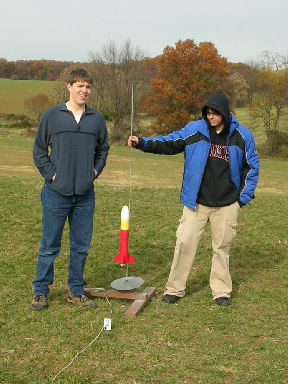 |
Explorer Post 1010 Lockheed Martin Exploring Program Launch November 17, 2007 |
 |
 |
Explorer Post 1010 Lockheed Martin Exploring Program Launch November 17, 2007 |
 |
 A
few of us (too few) traveled to the National Pike Park
launch site on Saturday, November 17, 2007. It was a cold windy
day, but we were ready. A
few of us (too few) traveled to the National Pike Park
launch site on Saturday, November 17, 2007. It was a cold windy
day, but we were ready. Objectives:
To launch the timer and ejection system, we used an old rocket from last year and an E9-8 engine. The E9 had it's own ejection charge which would go off at around 8 seconds after burnout. We tried it twice and both seem to work. We angled the launch tower into the wind, which reduced altitude, but helped get the rocket down away from the trees. We launched with a 60gram wooden egg in the nose cone, and used a old altimeter (version 1). We decided not to launch the V2 that afternoon because of the wind. There was too much risk in getting caught in the trees. Team 2 went out the next weekend, November 24, and launched the V2 with a G64. It reached an apogee of 881 feet (altimeter data). We need more flights to see if the G64s are consistent. Lessons
Launches
Pictures
|
|
Copyright 2008
Lockheed Martin Exploring Program Updated: January 2, 2008 |